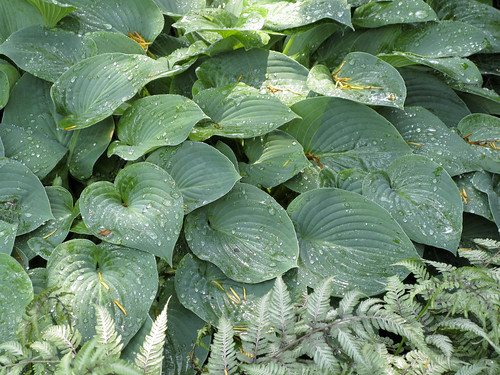Navigating Hostas
Posted in Gardening Tips on June 9 2011, by Ann Rafalko
 |
Sonia Uyterhoeven is Gardener for Public Education. |
 There is nothing inherently complex about hostas. They are easy-to-grow, readily available, adaptable foliage plants for the shade garden. The problem with hostas is that they have a predisposition toward mutation, and there is a glut of similar looking cultivars on the market.
There is nothing inherently complex about hostas. They are easy-to-grow, readily available, adaptable foliage plants for the shade garden. The problem with hostas is that they have a predisposition toward mutation, and there is a glut of similar looking cultivars on the market.
So how do you navigate the vast selection of these ubiquitous shade lovers to find a few outstanding specimens for your garden? The Azalea Garden provides an ideal opportunity for window shopping, offering ideas for choice cultivars and tips on how to integrate them into your woodland landscape design. In this new garden, azaleas are paired with ferns, sedges, grasses, and woodland perennials.
Hostas come from Japan, China, and Korea. The common name was once plantain-lily and the former Latin name, Funkia, was often used as a common name as well. There are around 45 species of hosta with over 7,000 cultivars. Two well-known species are the fragrant Chinese Hosta plantaginea and the waxy glaucous (blue) Japanese Hosta sieboldiana. They are parents to a myriad of successful cultivars on the market. Members of the plantaginea group tend to be heat lovers, while members of the sieboldiana group cannot take too much sun and warmth, their waxy blue coating starts to melt and turns green.
Hostas are notorious for having split personalities, meaning they sometimes change color during the course of the season. There are terms for this type of color instability: A hosta that changes from yellow or white to green is called viridescence; a change from green to yellow is called lutescence; and from yellow to white albescence.
Hostas are often classified by size: dwarf, miniature, small, medium, large, or giant. Each category has a different height range (given in inches) and average leaf size (given in square inches). For example, a giant hosta is over 28 inches tall and has a leaf surface area of greater than 144 square inches.
 Care
Care
Hostas hate dry soil; do not plant them directly under greedy trees such as Norway maples (Acer platanoides) or in dry areas. They prefer rich organic soil and good moisture. Before planting hostas, amend the soil with organic matter and add a light layer of organic mulch such as shredded leaves, which will help to continuously replenish the soil.
Hostas thrive in part shade and flourish with light morning sun. Afternoon sun is usually too hot, and the foliage tends to brown around the edges (this can sometimes be remedied with more moisture). The golden-leaved hostas are particularly susceptible to brown edges and are best planted in a shadier locations.
As a general rule, green-leafed hostas require less sun, while variegated hostas need more sun. Variegated plants are unable to photosynthesize in the variegated areas, which lack chlorophyll. Thus they need more sunlight to make up for the decrease in photosynthetic surface area.
For hostas to shine as foliage plants, give them a boost by fertilizing once in spring and an optional second application in mid-summer. You can either let your hostas grow into large clumps or periodically (every 4–5 years) divide them into smaller plants.
The best time to divide a hosta is either in spring when the tips are emerging or in August when the intense heat of the summer is beginning to subside. If you divide in August, you may want to cut off some of the larger leaves to prevent excessive water loss.
The largest concern for the hosta gardener is slugs; they have a preference for fragrant hostas and avoid thick-skinned varieties. The old fashion remedy is to place a saucer of beer in the garden to drown the slugs. Edging your prize hosta with either used coffee grounds (caffeinated) or with copper pennies also works, as does periodically sprinkling iron phosphate around your planting.
Highlights from the Azalea Garden
Hosta ‘Abiqua Drinking Gourd’—deeply cupped, medium, powder-blue foliage
Hosta ‘Blue Angel’*—giant, blue, heavily veined leaves
Hosta ‘Blue Mouse Ears’*—small, blue-green leaves
Hosta ‘Corkscrew’—narrow leaves with twisted tip
Hosta ‘First Frost’*—blue foliage with half-inch creamy-yellow border that changes to white
Hosta ‘Ginsu Knife’—waxy green foliage with serrated edges that change from yellow to cream
Hosta ‘Great Expectations’*—blue margins with a center that starts gold and changes to cream
Hosta ‘June’*—blue-edged leaves with creamy center that changes to chartreuse
Hosta ‘Liberty’*—upright growth with thick, dark-green foliage with wide golden edge
Hosta ‘Orange Marmalade’—green foliage with center turning yellow and then white
Hosta ‘Paul’s Glory’*—large, blue-green margins with yellow-green center
Hosta ‘Sagae’*—large, blue-green leaves with creamy margin
Hosta ‘Sum and Substance’*—enormous, chartreuse foliage good for floral arrangements
Hosta ‘Vulcan’—medium, dark-green foliage with bright-white center
Fragrant hostas
Hosta ‘Fragrant Blue’—small, heart-shaped, powder-blue leaves and white flowers
Hosta ‘Fragrant Bouquet’—light-green foliage with creamy margins and near-white flowers
Hosta ‘Guacomole’*—chartreuse foliage with wide green edges and white flowers
Hosta ‘Plantaginea’—medium, green, heart-shaped leaves with white flowers
Hosta ‘So Sweet’—small, green leaves with white margin and white flowers
Hosta ‘Stained Glass’*—medium, golden foliage with dark-green margin
Hosta ‘Sugar and Cream’—large, green foliage with white margin and pale-lavender flowers
*Selections from the American Hosta Society’s Popularity Poll


Is it true that hostas are candy to the huge population of deer in our area? I would love to plant them but have avoided them because I heard the deer munch them down to nothing.